An automatic sliding curtain system is an innovative and practical solution for modern homes and commercial spaces. It offers convenience, energy efficiency, and increased control over natural light and privacy. This system eliminates the need for manually pulling curtains and provides a hands-free operation, often through a remote control, wall switch, or smart home integration. Below, we’ll explore the various components, benefits, operation, and applications of automatic sliding curtains in a detailed manner.
### Components of an Automatic Sliding Curtain
An automatic sliding curtain system comprises several components that work in unison to provide seamless operation:
1. **Motor**: The heart of the system is the motor, which drives the opening and closing of the curtains. Motors can vary in size and power depending on the weight and length of the curtains. High-quality motors often come with silent operation and are designed to last for years.
2. **Tracks**: The curtains slide on a specialized track, which is installed along the top of the window or door. These tracks are designed to accommodate the curtain's weight and allow smooth motion. The track system is usually discreet and blends with the existing decor.
3. **Curtain Fabric**: Any type of curtain fabric can be used in these systems, from light, sheer curtains to heavy blackout drapes. The motorized system can handle various fabrics depending on the power of the motor.
4. **Control Mechanism**: Most automatic sliding curtain systems come with multiple control options, including:
- **Remote Control**: This is the most common control mechanism. Users can open and close the curtains at the touch of a button from anywhere in the room.
- **Wall Switch**: A manual switch can also be installed on the wall for easy access.
- **Smart Home Integration**: Advanced systems allow integration with home automation platforms like Google Home, Amazon Alexa, or Apple HomeKit. This allows voice control or automation based on timers or environmental conditions (e.g., temperature, time of day).
5. **Sensors**: Some systems are equipped with sensors that can detect sunlight levels or temperature, automatically adjusting the curtains based on the conditions. For example, they may close during peak sunlight hours to reduce heat gain and protect furniture from UV damage.
### Benefits of Automatic Sliding Curtains
1. **Convenience**: The primary advantage of automatic sliding curtains is convenience. They can be operated from a distance without having to get up, which is particularly helpful for individuals with mobility challenges or for large windows that are difficult to reach.
2. **Energy Efficiency**: These systems can help manage indoor temperatures by automatically closing the curtains during the hottest parts of the day, thus reducing the need for air conditioning. They can also open the curtains during cooler parts of the day to let natural light and warmth inside.
3. **Increased Privacy**: With the push of a button, users can close their curtains at any time, ensuring privacy. Some systems can be set to close automatically at certain times of day, such as at night, for added security.
4. **Smart Home Integration**: The ability to integrate with smart home systems means that curtains can become part of a larger automation scheme. For example, the curtains could close automatically when the television is turned on or when the home’s security system is activated.
5. **Aesthetics and Luxury**: Automatic sliding curtains contribute to a modern and luxurious aesthetic. They provide a clean, minimalist look with no visible cords or hardware. Their smooth operation adds a sense of elegance to any room, making them popular in high-end homes and hotels.
### Operation of Automatic Sliding Curtains
The operation of automatic sliding curtains is fairly straightforward. Upon installation, the curtain motor is connected to the control unit, which can be wired or wireless. Once installed, users can operate the curtains through:
- **Manual Command**: This includes using a remote control, pressing a wall switch, or using voice commands via a smart home system.
- **Automated Scheduling**: Many systems allow you to set schedules for the curtains to open and close at specific times, such as in the morning to let in natural light or at night for privacy.
- **Sensor-Based Automation**: Some systems work with light or temperature sensors, automatically adjusting the curtains based on environmental conditions. For instance, they might open during the day to maximize natural light or close during intense sunlight to keep the home cool.
https://expertautomationbd.com/automatic-sliding-curtain/
An automatic sliding curtain system is an innovative and practical solution for modern homes and commercial spaces. It offers convenience, energy efficiency, and increased control over natural light and privacy. This system eliminates the need for manually pulling curtains and provides a hands-free operation, often through a remote control, wall switch, or smart home integration. Below, we’ll explore the various components, benefits, operation, and applications of automatic sliding curtains in a detailed manner.
### Components of an Automatic Sliding Curtain
An automatic sliding curtain system comprises several components that work in unison to provide seamless operation:
1. **Motor**: The heart of the system is the motor, which drives the opening and closing of the curtains. Motors can vary in size and power depending on the weight and length of the curtains. High-quality motors often come with silent operation and are designed to last for years.
2. **Tracks**: The curtains slide on a specialized track, which is installed along the top of the window or door. These tracks are designed to accommodate the curtain's weight and allow smooth motion. The track system is usually discreet and blends with the existing decor.
3. **Curtain Fabric**: Any type of curtain fabric can be used in these systems, from light, sheer curtains to heavy blackout drapes. The motorized system can handle various fabrics depending on the power of the motor.
4. **Control Mechanism**: Most automatic sliding curtain systems come with multiple control options, including:
- **Remote Control**: This is the most common control mechanism. Users can open and close the curtains at the touch of a button from anywhere in the room.
- **Wall Switch**: A manual switch can also be installed on the wall for easy access.
- **Smart Home Integration**: Advanced systems allow integration with home automation platforms like Google Home, Amazon Alexa, or Apple HomeKit. This allows voice control or automation based on timers or environmental conditions (e.g., temperature, time of day).
5. **Sensors**: Some systems are equipped with sensors that can detect sunlight levels or temperature, automatically adjusting the curtains based on the conditions. For example, they may close during peak sunlight hours to reduce heat gain and protect furniture from UV damage.
### Benefits of Automatic Sliding Curtains
1. **Convenience**: The primary advantage of automatic sliding curtains is convenience. They can be operated from a distance without having to get up, which is particularly helpful for individuals with mobility challenges or for large windows that are difficult to reach.
2. **Energy Efficiency**: These systems can help manage indoor temperatures by automatically closing the curtains during the hottest parts of the day, thus reducing the need for air conditioning. They can also open the curtains during cooler parts of the day to let natural light and warmth inside.
3. **Increased Privacy**: With the push of a button, users can close their curtains at any time, ensuring privacy. Some systems can be set to close automatically at certain times of day, such as at night, for added security.
4. **Smart Home Integration**: The ability to integrate with smart home systems means that curtains can become part of a larger automation scheme. For example, the curtains could close automatically when the television is turned on or when the home’s security system is activated.
5. **Aesthetics and Luxury**: Automatic sliding curtains contribute to a modern and luxurious aesthetic. They provide a clean, minimalist look with no visible cords or hardware. Their smooth operation adds a sense of elegance to any room, making them popular in high-end homes and hotels.
### Operation of Automatic Sliding Curtains
The operation of automatic sliding curtains is fairly straightforward. Upon installation, the curtain motor is connected to the control unit, which can be wired or wireless. Once installed, users can operate the curtains through:
- **Manual Command**: This includes using a remote control, pressing a wall switch, or using voice commands via a smart home system.
- **Automated Scheduling**: Many systems allow you to set schedules for the curtains to open and close at specific times, such as in the morning to let in natural light or at night for privacy.
- **Sensor-Based Automation**: Some systems work with light or temperature sensors, automatically adjusting the curtains based on environmental conditions. For instance, they might open during the day to maximize natural light or close during intense sunlight to keep the home cool.
https://expertautomationbd.com/automatic-sliding-curtain/









